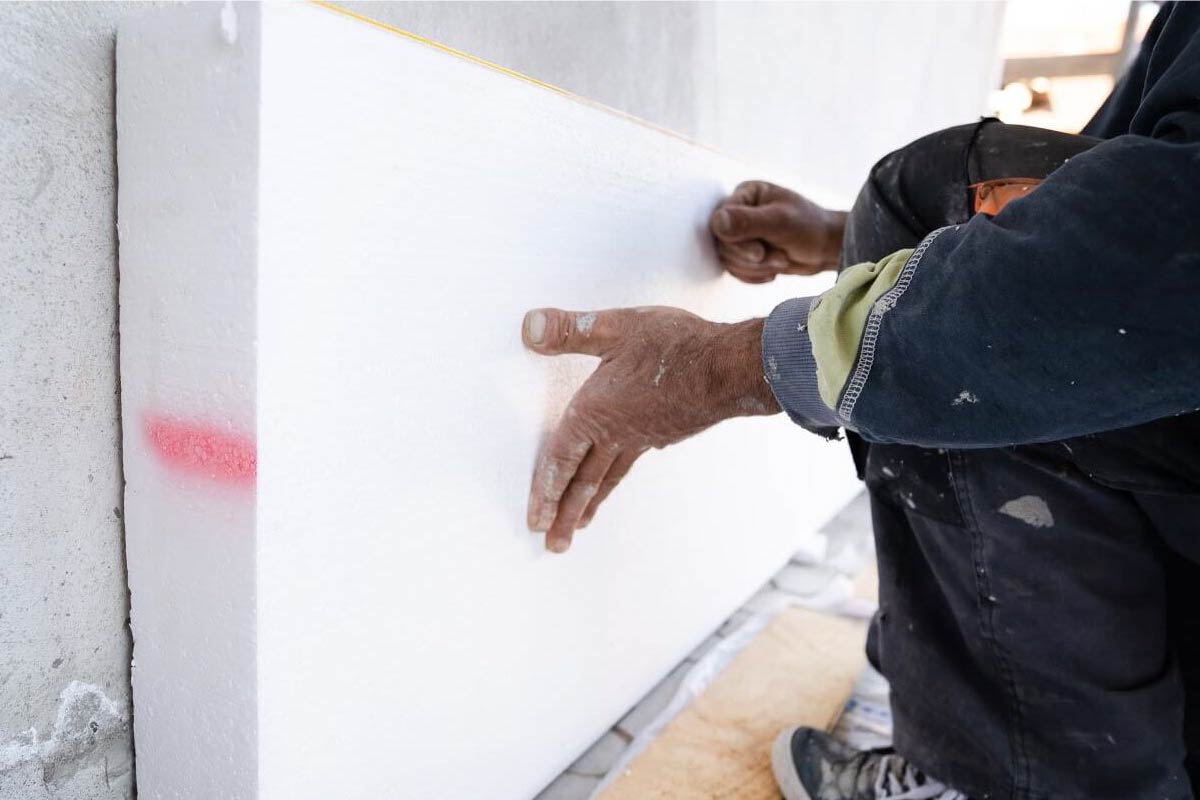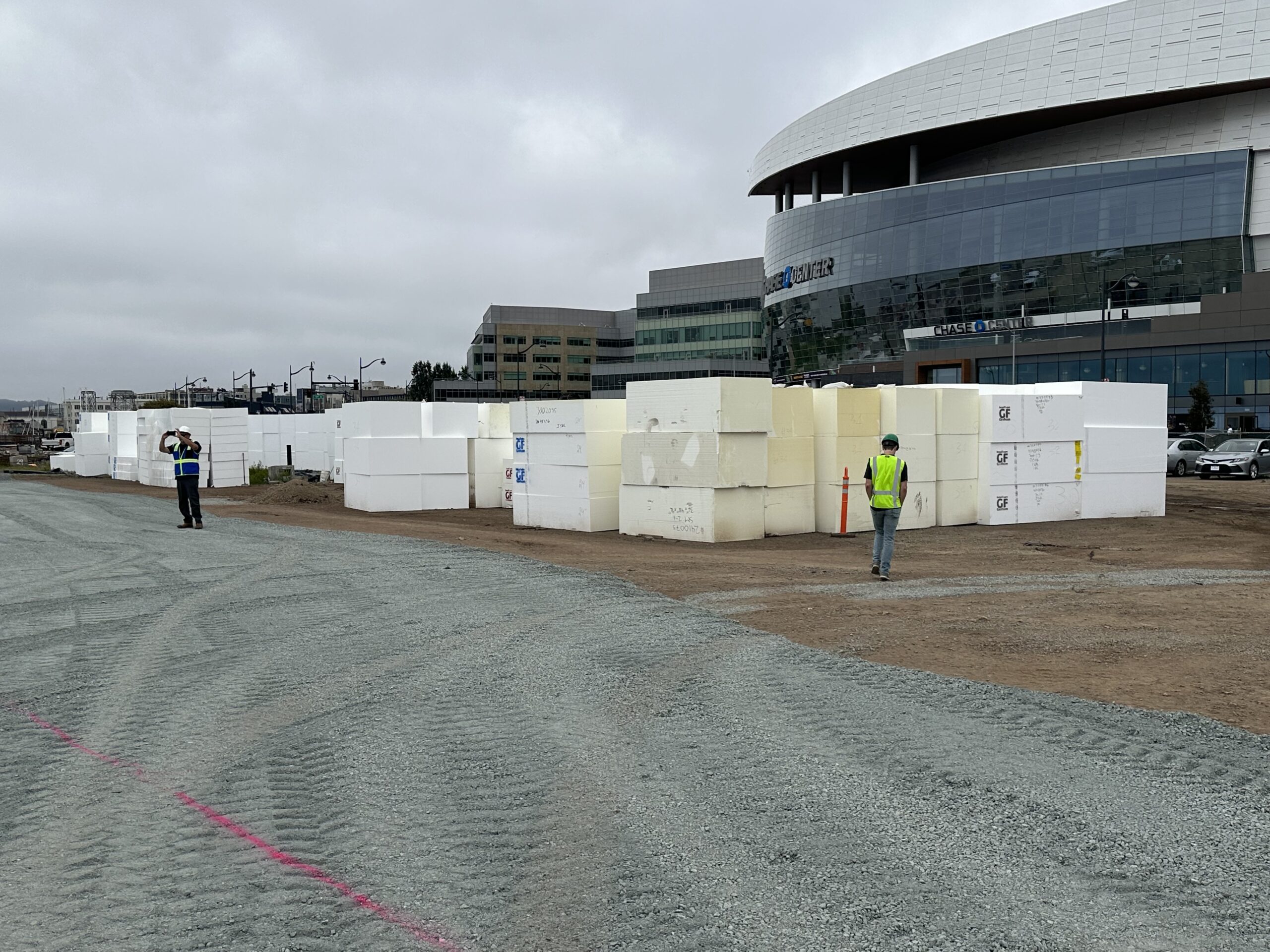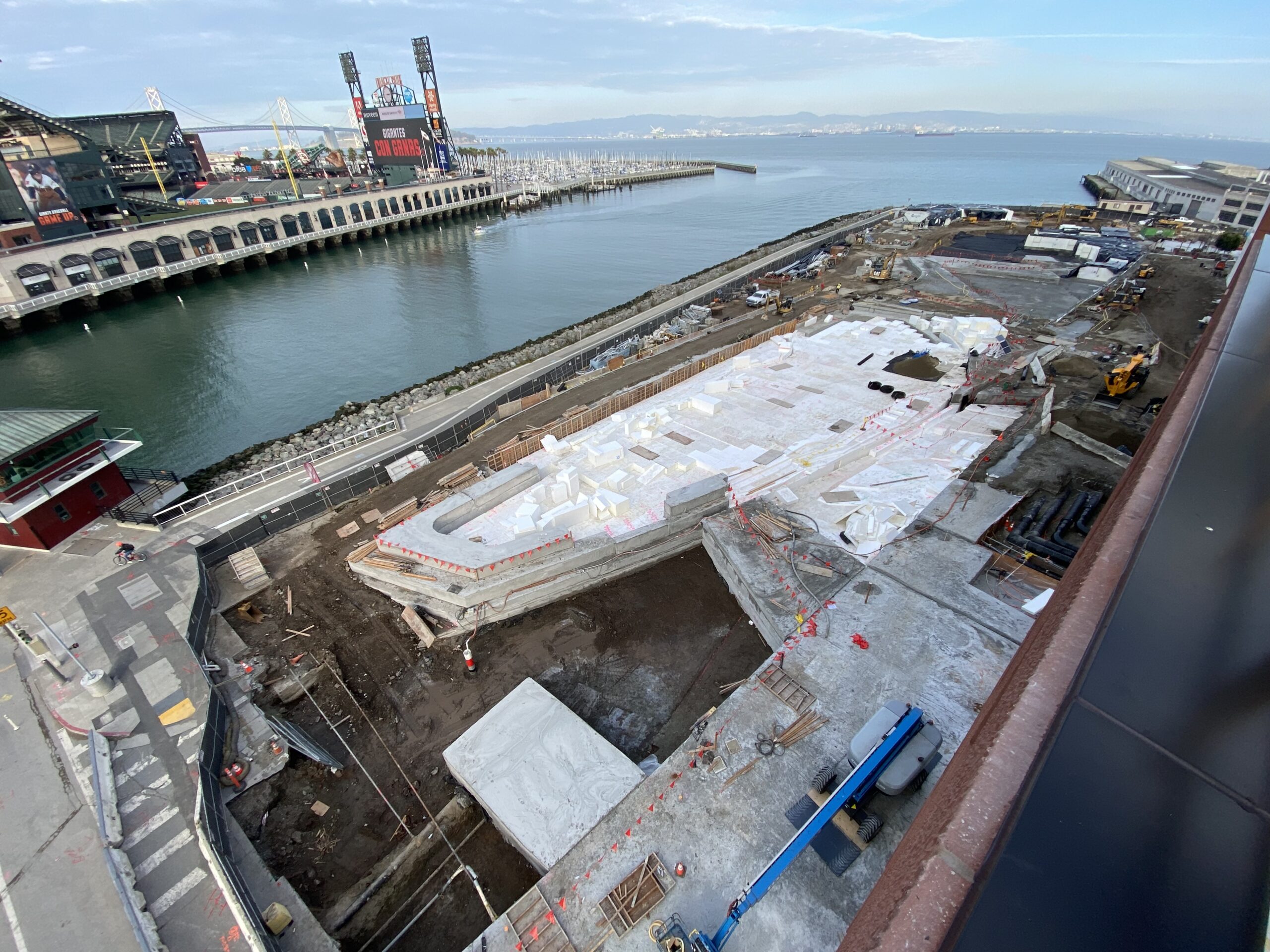XPS foam board is a rigid thermoplastic material manufactured from polystyrene. Polystyrene is a synthetic, hydrocarbon polymer derived from benzene and ethylene, two petroleum products.
XPS foam board is often used for above-grade insulation applications such as walls, ceilings, attics and roofs as well as for below-grade applications such as foundations and basements. When used above-grade, it can reduce thermal bridging and improve energy efficiency.
How Is XPS Foam Board Manufactured?
The manufacturing process for extruded polystyrene (XPS) foam products is similar to the manufacturing process of expanded polystyrene (EPS) foam products. Both begin with the same basic raw material. But in the case of extruded polystyrene, the polystyrene resin beads or granules are fed into an extruder, where they are heated at very high temperatures until molten. At that point, various additives are added to the molten mixture. One of those additives may be a coloring agent. XPS foam board is typically colored in a variety of colors to identify it as a particular brand. For example, Owens Corning XPS foam board is typically pink, while Dow XPS foam board is typically blue. A blowing agent is also added to enable the product to expand after the extrusion process. Using carefully controlled heat and pressure, the plastic mixture is forced through a die (extruded), then allowed to cool and expand into the desired shape. The resulting foam board is then trimmed to the final product dimensions. Because the foam board is extruded rather than poured into molds like EPS foam board, the thickness of the XPS product is limited.
Thermal Properties
R-value is a measure of a material’s resistance to heat transfer. It is dependent upon the thickness and density of the building material. The higher the R-value, the greater the material’s ability to resist conductive heat transfer and the better its performance as an insulating material. XPS foam board has a uniformly distributed closed-cell structure, which helps it achieve an initial R-value of about R-5 per one inch (25 mm). According to the U.S. Department of Energy, XPS foam board provides up to two times more thermal resistance than most other insulating materials of the same thickness,
The continuous extrusion process used to manufacture XPS foam board produces a homogenous, closed-cell cross section, with each cell fully enclosed by polystyrene walls, leaving no voids. That helps the R-value of XPS foam board retain a uniform and reliable R-5 thermal rating for the long-term, regardless of its density.
However, XPS cells contain insulating gases or blowing agents, in addition to air, that eventually diffuse out of the cells. This process is called “aging.” In effect, the aging process can degrade the insulating value of the XPS foam board over time, making its long-term thermal resistance less than the stated initial R-value.
Because of its high thermal properties, using XPS foam board in building construction can help reduce the amount of energy needed to heat and cool the building. Rigid board insulation such as XPS foam board can potentially help homeowners save up to 40 BTUs of energy for each BTU of energy consumed by the home’s heating and cooling systems. In older homes, that could increase the energy efficiency of the home by up to 70%.
Moisture Absorption Resistance
A permeance or “perm” rating is a standard measure of the water vapor permeability of a material. Unlike the R-value, in which the higher the number, the better, a material with a lower perm rating is better at retarding movement of water vapor. Resistance to moisture absorption is important because water is an excellent conductor of heat.
Very little water can permeate XPS foam board’s closed-cell structure, making it easier for XPS foam board to provide a fairly constant thermal resistance. Typically, XPS foam board has enough water resistance capabilities to deal with normal basement and foundation moisture levels unless the home is located in a flood plain.
Unfaced, one-inch thick XPS foam board has a perm rating of about 1.0 making it a Class II semi-permeable vapor retarder. But the real test of an insulation is its ability to not only resist moisture but to readily release any moisture it does absorb, referred to as “drying potential.” The drying potential for thermal insulation is critical to maintaining the structure’s thermal resistance. Some tests have shown that over time XPS foam board may actually absorb more moisture in below-grade applications and retain that moisture for longer periods of time than EPS foam products. The potential to retain moisture can degrade the initial R-value of the XPS foam board over time, lowering its long-term R-value and effectiveness as insulating material.
Other Properties
Compressive Strength. XPS foam board is a rigid material with a very high compressive strength. The product’s homogenous, closed-cell cross section, with a lack of voids and each cell fully enclosed by polystyrene walls, contributes to its impressive strength. Products are available in a range of compressive strengths to meet different applications. XPS foam board can be manufactured up to 100 psi or more.
Ability to inhibit growth of biological air contaminants. Moisture promotes the growth of many organisms such as mold, mildew, fungi and other bacteria. XPS foam board is water resistant and can inhibit the growth of these organisms.
Durability. Since XPS foam board is a thermoplastic material, it will not rot or decompose over time. It is also resistant to microorganisms in the soil. And, it isn’t attractive to rats and other vermin as a source of food. It has a lifespan of up to 50 years.
Chemical inertness. XPS foam board is considered to be a fairly chemically inert material. It is resistant to most acids, bases and aqueous solutions of salts and alkalis. However, many organic solvents such as acetone, chlorinated solvents and aromatic hydrocarbon solvents can attack the foam and cause it to dissolve.
Size and density. XPS foam board can be manufactured with or without plastic facings. Due to the limitations of the extruded manufacturing process, it is most often available only in standard dimensions and in sheet (board) form, with foam board typically manufactured in 4-foot by 8-foot sheets. XPS foam board is quite dense — 2.18 pounds on average per cubic foot. That makes it very durable.
Cost. XPS foam board is one of the more economical of the rigid foam board options on the market. A one-inch thick XPS foam board costs about $0.47 per square foot.
Energy efficiency. XPS foam board is an energy-efficient building material. Far more energy is saved over the lifetime of a building insulated with XPS foam board than is used during the manufacturing process for producing the product. A study by Franklin Associates showed this over the 50-year life of a home that used XPS foam insulation.
Dimensional stability. XPS foam board expands significantly and warps at higher temperatures.
Sustainability. When used as insulation for a home or building, XPS foam board has been shown to reduce the amount of energy required to maintain its heating and cooling, thus reducing the consumption of our already depleted natural resources. And, since polystyrene resin, a thermoplastic material, is used in manufacturing XPS foam board, the foam board can be melted down and reused to produce new XPS insulation. More importantly, that’s common practice today. According to the Extruded Polystyrene Foam Association, XPS manufacturing plants create no “scrap” or waste material because 100% of industrial waste XPS foam boards are recovered, broken down to the resin material and reused in the XPS foam manufacturing process.
Environmental Impact
As we have seen, XPS foam board is a sustainable product, which can be melted down and reused to manufacture more product. It is also an energy-efficient product, saving far more energy than was used to manufacture it. And, with an initial R-value of 5 per inch, using XPS foam board can significantly reduce the amount of energy needed to heat and cool the building. That helps preserve our natural resources. In fact, XPS foam board has earned an Energy Star® qualification.
XPS foam board possess most of the key attributes of a “green” building material. It is energy-efficient, sustainable, has good thermal resistance and water absorption resistance, and is durable and long-lasting—up to 50 years. And since it’s a man-made material, it reduces usage of natural resources.
But not all aspects of XPS foam products are as environmentally friendly. For one thing, XPS foam typically contains dyes to color the product to differentiate it by brand. Depending on the type of dye used, it could potentially be harmful to the environment.
The blowing agents used in the extruded manufacturing process can also deplete the ozone layer and contribute to global warming. XPS foam board often uses hydrochloroflurorcarbons (HCFCs) as the blowing agent. The blowing agent penetrates the XPS cells during the manufacturing process. Eventually, in a process called “aging,” the blowing agent diffuses out of the cells and into the environment. Some manufacturers are beginning to use blowing agents that are not harmful to the environment, but this is not yet standard practice across the board.








